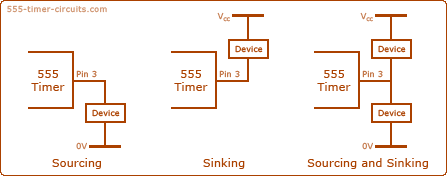Using the Output of a 555 Timer
The output (Pin 3) of the 555 can be in one of two states at any time, which means it is a digital output. It can be connected directly to the inputs of other digital ICs, or it can control other devices with the help of a few extra components. The first state is the 'low' state, which is the voltage 0V at the power supply. The second state is the 'high' state, which is the voltage Vcc at the power supply.
Sinking and Sourcing
When the Output goes low, current will flow through the device and switch it on. This is called 'sinking' current because the current is sourced from Vs and flows through the device and the 555 to 0V.
When the Output goes high, current will flow through the device and switch it on. This is called 'sourcing' current because the current is sourced from the 555 and flows through the device to 0V.
Sinking and sourcing can also be used together so that two devices can be alternately switched on and off.

The device(s) could be anything that can be switched on and off, such as LEDs, lamps, relays, motors or electromagnets. Unfortunately, these devices have to be connected to the Output in different ways because the Output of the 555 can only source or sink a current of up to 200mA. Make sure your power supply can provide enough current for both the device and the 555, otherwise the timing of the 555 will be affected.
Prev Page:
Operating Modes


